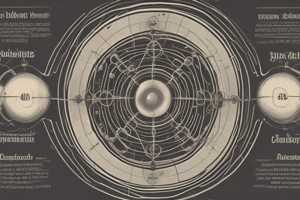Podcast
Questions and Answers
¿Cuál es el valor del número de Avogadro?
¿Cuál es el valor del número de Avogadro?
- 6.022140857 × 10^24 partículas
- 6.022140857 × 10^25 partículas
- 6.022140857 × 10^22 partículas
- 6.022140857 × 10^23 partículas (correct)
¿Cuál es la unidad de masa atómica?
¿Cuál es la unidad de masa atómica?
- Una décima parte de la masa de un átomo de carbono-12
- Una milésima parte de la masa de un átomo de carbono-12
- Una centésima parte de la masa de un átomo de carbono-12
- Una duodécima parte de la masa de un átomo de carbono-12 (correct)
¿Para qué se utiliza el número de Avogadro?
¿Para qué se utiliza el número de Avogadro?
- Para determinar la fórmula molecular de una sustancia
- Para convertir entre la cantidad de una sustancia (moles) y el número de partículas que contiene (correct)
- Para calcular la masa molecular de una sustancia
- Para calcular la densidad de una sustancia
¿Cuál es la fórmula para calcular la masa atómica?
¿Cuál es la fórmula para calcular la masa atómica?
¿Qué es la masa atómica?
¿Qué es la masa atómica?
¿Por qué es importante el número de Avogadro?
¿Por qué es importante el número de Avogadro?
Flashcards are hidden until you start studying
Study Notes
Atomic Mass
What is the Avogadro's Number?
- Avogadro's number (NA) is a fundamental constant in chemistry and physics.
- It is defined as the number of particles (atoms or molecules) in one mole of a substance.
- The value of Avogadro's number is 6.022140857 × 10^23 particles.
Importance of Avogadro's Number
- Used to convert between the amount of a substance (moles) and the number of particles it contains.
- Essential in calculating the atomic mass of an element.
- Helps to establish the relationship between the atomic mass unit (amu) and the gram.
Calculation of Atomic Mass using Avogadro's Number
- Atomic mass (A) is the total mass of all atoms in a mole of an element.
- Atomic mass unit (amu) is one-twelfth the mass of a carbon-12 atom.
- The atomic mass of an element can be calculated using the following formula: A = (total mass of atoms in a sample) / (number of moles) = (total mass of atoms in a sample) / (NA × number of atoms in a sample)
Note: These notes provide a concise overview of Avogadro's number and its significance in calculating atomic mass.
Studying That Suits You
Use AI to generate personalized quizzes and flashcards to suit your learning preferences.




